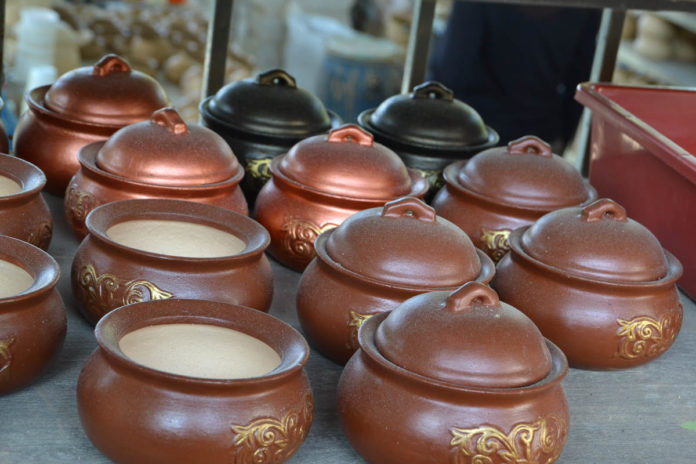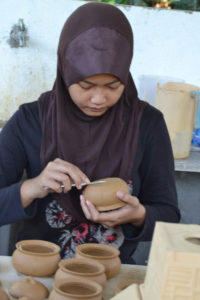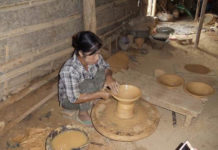
There are two main types of pottery made by the Malays: tall, gourd-shaped water containers (labu air) for storage of drinking water, in Sayong village in Perak, and round-bottomed, wide-mouthed cooking pots (belanga), in Mambong village and Bunut Payong in Kelantan.
In Sayong, where the potters are predominantly women, labu air are made from grey clay gathered from the banks of the nearby Perak River, which is sieved to remove stones and kneaded to remove air bubbles. The potters build up each piece by hand with a succession of clay rings spun on a simple board, pressed gently and raised to form an out-turned foot rim, bulbous body, gently bulging neck and slightly everted mouth rim. A wooden paddle is used to shape the body and river pebbles to smooth the surface. Vertical ribs, as well as crisscrossing lines, are carved into the body of the vessel, while geometric designs such as the bamboo shoot (pucuk rebung) carved on the ends of sticks may be stamped at the base of the neck. The labu is then left to dry for two or three days before being slowly wood-fired over a shallow pit, then plunged into pre-heated rice husks, causing the colour to change from grey to black. Finally, the surface is burnished with a stone or seashell.
Mambong and Bunut Payong in Kelantan are known for their simple unglazed reddish or terracotta cooking pots with wide, thin rims, rounded bodies (that provide for even distribution of heat and are thus favourable for curries), handles and covers. At both places, the clay dug from riverbanks is resilient and does not crack easily. It is moulded by hand, although at Mambong moulds made of plaster of Paris are also used. Once the objects have been shaped, painted and dried, they are dipped into liquid glaze to fix the shape and seal the hand-drawn designs. The pottery also acquires a shine with the glazing. Both places also produce a variety of other items, including, at Bunut Payong, gift items such as miniature pots, pencil holders, money boxes and refrigerator magnets. More sophisticated items, including decorative vases and art pieces, are produced using the same techniques.
[Pottery Fig. 1]
Jeffri Din Mat, a potter entrepreneur who owns Belipot Craft Pottery in Kota Bharu, Kelantan, displays his own moulds made of plaster of Paris that shape the form of his pottery works. (Photograph by Ghulam-Sarwar Yousof)
[Pottery Fig. 2]
Excessive clay from the small pottery pieces produced being scraped off by the daughter of Jeffri Din Mat. (Photograph by Ghulam-Sarwar Yousof)
[Pottery Fig. 3]
Samples of completed ceramic pots produced at Belipot Craft Pottery, Kota Bharu. (Photograph by Ghulam-Sarwar Yousof)






